9 Best Rifle Bipods for Hunting and Shooting in 2025
Last Updated on
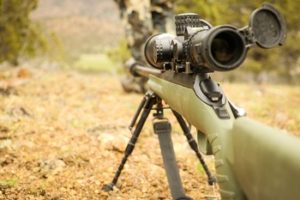
When you’re heading out for a hunt, you want to be able to hit every shot. But depending on what you’re hunting, you might be doing more than sitting up in a tree stand, or your target might be farther away than you expected.
That’s where a bipod comes in. It gives you a steady surface to hold up the front end of your rifle, which helps improve your accuracy and can give you the ability to hit targets that are farther away. But while the right bipod can improve your aim, the wrong one can send your shot off target.
That’s why we compiled reviews of the nine best rifle bipods for hunting and shooting. This way, when you hit the field, you can also hit your target.

A Quick Comparison (updated in 2025)
| Image | Product | Details | ||
|---|---|---|---|---|
| Best Overall |
 |
HBLS Harris Bipod |
|
CHECK PRICE |
| Best Value |
 |
XAegis Carbon Fiber |
|
CHECK PRICE |
| Premium Choice |
 |
Atlas BT46 |
|
CHECK PRICE |
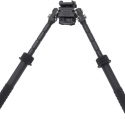 |
Atlas V8 Series |
|
CHECK PRICE | |
 |
Magpul Rifle Bipod |
|
CHECK PRICE |
The 9 Best Rifle Bipods
1. HBLS Harris Rifle Bipod — Best Overall
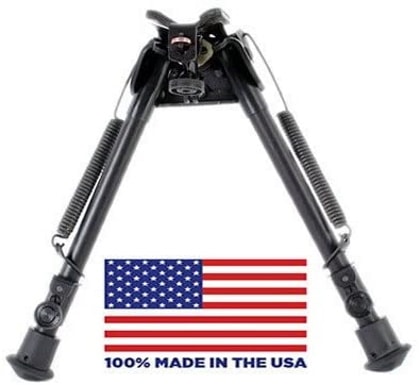
- Extension range: 9” to 13”
- Mounting style: Swivel stud
- Construction material: Hardened steel and hard alloys
If you’re looking for the best possible combination of price and performance, then the HBLS Harris Bipod is precisely what you’ve been looking for. It’s incredibly lightweight yet durable, and it can handle almost any rifle setup.
Moreover, the spring-loaded legs are easy to use and allow you to use this bipod on uneven terrain with ease. However, this bipod does not come with any mounting adapters, so if you prefer or need something other than a swivel stud, you’ll need to spend more money.
The 9” to 13” extension range is longer than most other bipods offer, making it a versatile option. It’s a durable bipod that gets the job done and will last year after year and shot after shot.
- Lightweight design
- Can handle larger rifles
- Made in the U.S.A.
- Spring-loaded legs
- A great mix of price and performance
- No mounting adapters
2. XAegis Carbon Fiber Rifle Bipod — Best Budget
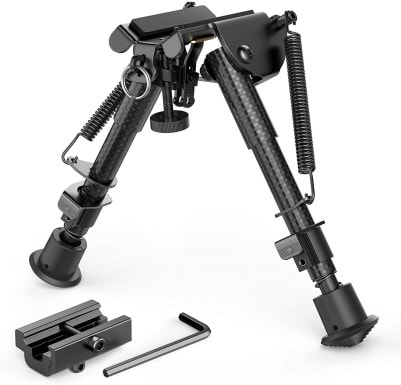
- Extension range: 6” to 9”
- Mounting style: Swivel stud (Picatinny rail adapter)
- Construction material: Carbon fiber
Just because you don’t want to spend a ton of money doesn’t mean you can’t get a top-notch bipod. The XAegis bipod makes the most out of every inch by sticking with a carbon fiber design. Carbon fiber is stronger than steel but lighter than aluminum, giving you the best of both worlds with a product that will last.
Additionally, it has spring-loaded legs that make it easy to use. But this is a budget bipod, which means there are a few things that you’re giving up. First, this bipod doesn’t swivel, which can make it cumbersome to line up different shots.
It also doesn’t adapt well to uneven terrain. That means if you’re out in the field and don’t have a clean platform, using this bipod can get tricky. But at this price point, it’s still a great option.
- Affordably priced
- Durable construction
- Lightweight design
- Spring-loaded legs
- It does not swivel
- It does not adapt well to uneven terrain
- You might also be interested in: 10 Best Rifle Scopes Under $100 — Reviews & Top Picks
3. Atlas BT46 Rifle Bipod — Premium Choice
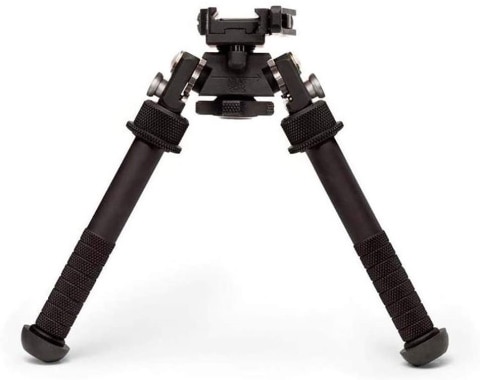
- Extension range: 5” to 9”
- Mounting style: Picatinny rail
- Construction material: Aluminum and stainless steel
If you’re looking for the best rifle bipod for hunting and shooting, go with Atlas and never look back. The best that Atlas has to offer is the BT46 line. It’s exceptionally durable and lightweight, and it comes with a lifetime warranty that gives you extra peace of mind, considering the higher cost.
The BT46 utilizes a Picatinny rail mounting system with a quick-release lever, which allows you to line up and move after each shot with ease. Even better, it adapts well to any conditions, so you can line up any shot with ease.
In fact, the only thing that we can ding this bipod for is the price. It’s more than three times the price of other premium bipods, putting it into a class of its own.
- Independent leg movements
- Made in the U.S.A.
- High-quality and durable
- Quick-release lever
- Can handle almost any rifle
- Lifetime warranty
- Expensive
4. Atlas V8 Series Bipod
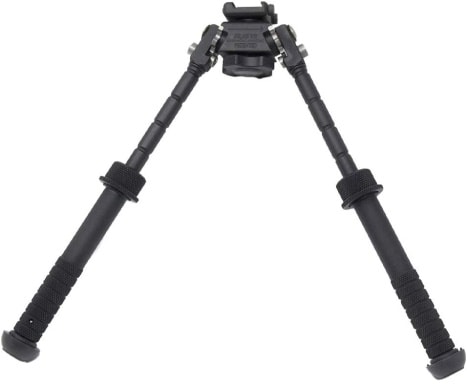
- Extension range: 5” to 9”
- Mounting style: Picatinny rail
- Construction material: Aluminum and stainless steel
If you want an Atlas bipod but can’t stomach the price of its BT46, the V8 series might be more your speed. It’s still almost twice as expensive as most other bipods, but that’s still a discount over the BT46.
This rifle bipod is incredibly durable and extremely lightweight and can handle almost any rifle. In fact, the only difference between this bipod and the more expensive BT46 is the attachment method for the Picatinny rail and rifle.
While the BT46 uses a quick-release lever, the V8 series uses two Allen screws. Both are incredibly effective at holding your rifle in place, but the Allen screws take more time to set up and take out.
- Made in the U.S.A.
- Independent leg movements
- Lightweight option
- Can handle almost any rifle
- Expensive option
- It utilizes an Allen screw attachment method
5. Magpul Rifle Bipod for Rifle
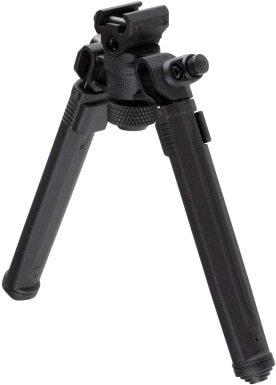
- Extension range: 6.3” to 10.3”
- Mounting style: Picatinny rail, 17S, M-LOK, or swivel stud
- Construction material: Aluminum and polymer
Rounding out the top five best rifle bipods for hunting and shooting is the Magpul Rifle Bipod. What sets this bipod apart from the pack is the slightly longer extension range and the ability to pick your mounting style while ordering.
Magpul offers four different mounting options when you make your purchase. This makes it extremely easy to mount to your rifle setup, no matter what you’re shooting.
Moreover, it’s easy to set up, use, and transport, making it an all-around excellent choice. While the Magpul Rifle Bipod is not quite as durable as Atlas bipods, it’s still a long-lasting option and not nearly as expensive.
- Good mix of price and performance
- Easy to make one-handed adjustments
- Spring-tension legs are easy to set up and use
- The foldable design is great for transportation and storage
- Not as durable as Atlas bipods
6. CVLIFE Tactical Rifle Bipod

- Extension range: 6” to 9”
- Mounting style: Swivel stud (Picatinny rail adapter)
- Construction material: Hardened steel and aluminum
CVLIFE makes budget optics, so it’s no surprise that it has a budget bipod too! This bipod is extremely affordable, but that doesn’t mean it won’t last. With a hardened steel and aluminum construction, it’s one of the more durable budget bipods.
Moreover, it’s easy to transport and use with its foldable design. However, there are rigid height ranges, making it harder to use with uneven terrain. Additionally, this bipod does not have a swivel or pivot feature, which limits its overall versatility.
- Affordable
- Foldable design makes it easy to transport
- Easy to use
- Set height ranges — not extremely versatile for uneven terrain
- No swivel or pivot feature
7. Caldwell XLA Pivot Bipod
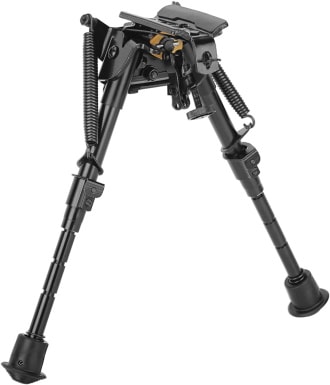
- Extension range: 6” to 9”, 9” to 13”, 13” to 23”, or 13.5” to 27”
- Mounting style: Swivel stud
- Construction material: Aluminum and steel
The Caldwell bipod is an affordable yet functional option for your rifle. While it’s incredibly lightweight and affordable, the soft aluminum construction means that with a few bumps and bangs in the field, you might end up with a dented bipod.
But this bipod has a wide array of height options. Anything from 6” to 27” is covered, which means no matter what situation you’re trying to set up your rifle in, Caldwell has an option for you.
- Spring-loaded legs
- Tons of height options
- Affordably priced
- Lightweight
- Easily dented and damaged
8. UTG Recon Flex M-LOK(R) Bipod
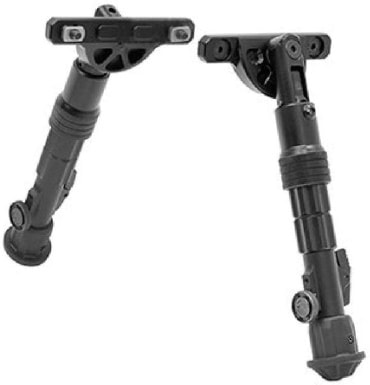
- Extension range: 5.7” to 8”
- Mounting style: M-LOK
- Construction material: Aluminum
As the name implies, the UTG Recon Flex M-LOK(R) Bipod utilizes an M-LOK design, which means you likely won’t be removing this bipod between shots. However, since the bipod tucks into the rifle, the fact that it can be easily dented and damaged is mitigated a bit.
Moreover, the bipod uses a spring-loaded side-locking ring that makes deploying this bipod a breeze in the field. Furthermore, it’s incredibly lightweight, which is a big deal, considering that you won’t be removing the bipod from your rifle between shots.
If you’re looking for an M-LOK style bipod, it’s a good choice, but we recommend a more conventional swivel stud for most users.
- Affordably priced
- Spring-loaded side locking ring
- Lightweight
- Easily dented and damaged
- M-LOK design makes it challenging to remove and reinstall in the field
- It does not swivel
9. AVAWO Hunting Rifle Bipod
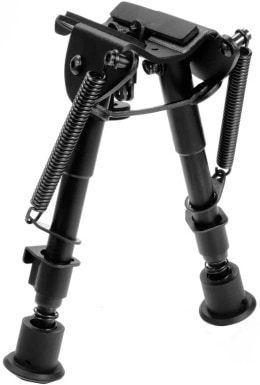
- Extension range: 6” to 9”
- Mounting style: Swivel stud
- Construction material: Hardened steel and aluminum
The AVAWO hunting rifle bipod is one of the most affordable options, but don’t expect this bipod to last forever. It’s not that durable, and it’s easily damaged. That said, while it lasts, you are getting a decent option.
We consider this one of the best bipods for hunting and shooting because it’s extremely lightweight, and the foldable design makes for easy transportation and use in the field. If you’re in a pinch, you can get this bipod, but we recommend spending a little more to get a more durable bipod the first time.
- Affordably priced
- Lightweight
- The foldable design is easy to transport
- Easily dented and damaged
- Not that durable

Buyer’s Guide – Choosing the Best Rifle Bipod for Hunting and Shooting
You might find yourself wondering why you need a bipod for your rifle at all. Or, after reading the reviews, you might be wondering what specs matter and what they all mean.
That’s why we came up with this comprehensive buyer’s guide that will walk you through everything that you need to know before you make your purchase. We know that it can be overwhelming!
Why You Want a Rifle Bipod

If you’ve fired a gun a time or two, you know that stability is king. There’s no better way to improve your stability than with a bipod. It holds the front of your rifle steady, so all you need to do is line up and take your shot.
Even better, bipods are incredibly versatile and transportable. If you can’t get into a prone shooting position, you can set up your bipod and get similar accuracy whether you’re standing or crouching.
If you are in a prone position, a bipod will improve your accuracy further! If you’re out hunting, don’t be stubborn — there’s no shame in using one to guarantee your shot and head home happy! In fact, American special forces use Aimpoint bipods.
- You might also be interested in: 4 Best Long-Range Spotting Scopes for 1000+ Yards – Top Picks & Reviews
Rifle Bipod Construction Materials
When you’re looking at bipods, one of the most important factors that you need to look at is the materials from which the manufacturer made the bipod. The most common materials are steel and aluminum.
Steel is tough and durable, but it’s also a bit heavier than aluminum. However, aluminum is a softer metal, so it’s easier to dent and bend when you don’t want it to. That’s why many options combine both materials to give you the best of both worlds.
However, an interesting choice is the XAegis Carbon Fiber bipod. As the name implies, it uses carbon fiber instead of steel and aluminum, which is an excellent alternative because it’s stronger than steel and lighter than aluminum.
Rifle Bipod Mounting Options

One of the most important things that you need to look into when deciding on a bipod for your rifle is the mounting options. There are three common mounting options for bipods: swivel studs, M-LOC, and Picatinny rails.
The truth is that each option has its own set of perks and drawbacks. The Picatinny rail is extremely popular because it’s the most common type of mounting system on a rifle, so you often don’t need to add anything new to use these style mounts. Moreover, they give you an extremely snug fit. Since the rails go up and down the length of your rifle, you can pick the perfect location to mount your bipod. However, not every rifle has Picatinny rails.
Another common option is the swivel stud. This used to be an extremely common option for any rifle, but most modern rifles have switched to a Picatinny rail system. Still, there are plenty of adapters if your bipod has this mounting option.
Finally, M-LOC mounts are extremely different from both Picatinny rails and swivel studs. A bipod with an M-LOC mounting system attaches to each side of the rifle instead of underneath. This means that M-LOC bipods usually come in two parts, and each one attaches with two different Allen screws.
That means to attach an M-LOC mount, you will need to install four different screws, which isn’t something that you want to deal with in the field. But the tradeoff is that you can fold the mount up and deploy it at a moment’s notice with a button press.
Some users love the M-LOC system because of this, while others can’t stand the added bulkiness that it puts on the front of the rifle.
Notes on Leg Adjustments
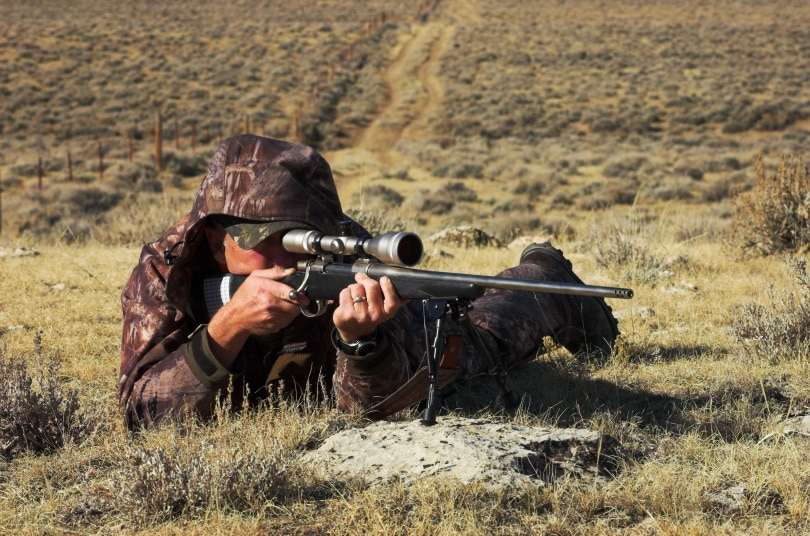
While every feature matters, one that you don’t want to overlook is leg adjustments. First, it determines how high your bipod goes. That’s a big deal because it’s going to affect the rest of your shooting position.
From there, you want legs that raise and lower independently, preferably with a spring-loaded design. This allows you to use your bipod on uneven surfaces. Furthermore, the spring-loaded legs enable you to deploy them for each situation with a click of a button.
This way, you don’t have to adjust each leg manually, and it saves you a ton of time, so you won’t miss your shot while setting up your equipment.

Conclusion
Hopefully, after reading through the reviews and buyer’s guide, you have a great understanding of what you need and want for your rifle bipod. But if you’re still unsure, why not go for the HBLS Harris Bipod? It’s our pick for the best rifle bipod for hunting and shooting for a reason, with its outstanding blend of price and performance, and we’re sure it won’t disappoint you.
However, if you’re looking for a lower-end option to tide you over, the XAegis Carbon Fiber bipod is a great choice that will last year after year. The truth is that there are tons of great options out there, so no matter which one you go with off our list, you’ll be happy with your purchase!
- You might also be interested in: 7 Best Scopes for .22-250 Rifles — Reviews & Top Picks
Featured Image Credit: ddefillipo, Pixabay
Table of Contents
- A Quick Comparison (updated in 2025)
- The 9 Best Rifle Bipods
- 1. HBLS Harris Rifle Bipod — Best Overall
- 2. XAegis Carbon Fiber Rifle Bipod — Best Budget
- 3. Atlas BT46 Rifle Bipod — Premium Choice
- 4. Atlas V8 Series Bipod
- 5. Magpul Rifle Bipod for Rifle
- 6. CVLIFE Tactical Rifle Bipod
- 7. Caldwell XLA Pivot Bipod
- 8. UTG Recon Flex M-LOK(R) Bipod
- 9. AVAWO Hunting Rifle Bipod
- Buyer’s Guide – Choosing the Best Rifle Bipod for Hunting and Shooting
- Why You Want a Rifle Bipod
- Rifle Bipod Construction Materials
- Rifle Bipod Mounting Options
- Notes on Leg Adjustments
- Conclusion
About the Author Robert Sparks
Robert’s obsession with all things optical started early in life, when his optician father would bring home prototypes for Robert to play with. Nowadays, Robert is dedicated to helping others find the right optics for their needs. His hobbies include astronomy, astrophysics, and model building. Originally from Newark, NJ, he resides in Santa Fe, New Mexico, where the nighttime skies are filled with glittering stars.
Related Articles:
What Is the Best Binocular Magnification for Hunting? Optical Features Explained
How to Clean a Refractor Telescope: Step-by-Step Guide
How to Clean a Telescope Eyepiece: Step-by-Step Guide
How to Clean a Rifle Scope: 8 Expert Tips
Monocular vs Telescope: Differences Explained (With Pictures)
What Is a Monocular Used For? 8 Common Functions
How to Clean a Telescope Mirror: 8 Expert Tips
Brightfield vs Phase Contrast Microscopy: The Differences Explained



